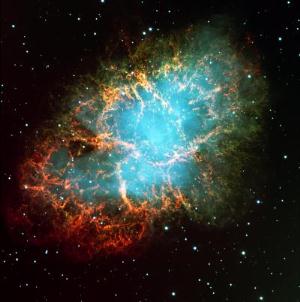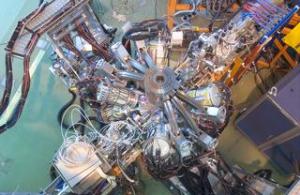 |
A new discovery, and the questions it raises, could help explain in greater detail how elements are synthesized in stellar explosions - such as the supernova that left behind the Crab Nebula.
[Credit: VLT/ESO] |
 |
REX-ISOLDE, an accelerator for radioactive ion beams at CERN.
[Credit: Maximilien Brice / CERN] |
The cauldron of a supernova gives birth to a whole array of high-mass atomic nuclei, which decay to stable elements via different short-lived intermediate stages. Analogous to the shell model for electrons, nuclear physicists developed a model that predicts particularly high stability for specific combinations in the number of neutrons and protons. These are the "magic numbers": the shells are full and the nuclei nearly spherical.
However, there are "magic" nuclei that deviate from the expected shell structure. An international collaboration under the direction of physicists from the Cluster of Excellence Origin and Structure of the Universe at the TUM took a closer look at the nuclei in a domain with the magic neutron number 20, also known as the "island of inversion." Their measurements with REX-ISOLDE, an accelerator for radioactive ion beams at CERN, led to surprising results.
In their experiment the scientists studied the neutron-rich isotope magnesium-32 by shooting a magnesium-30 beam at a titanium film loaded with tritium, a radioactive isotope of hydrogen. In a so-called pair transfer reaction, two neutrons are knocked off the tritium and transferred to the magnesium nucleus, thus turning it into magnesium-32.
The neutron-rich isotope magnesium-32, whose nucleus has 20 neutrons and 12 protons, is supposed to be magic and, as such, should have a spherical shape. However, the lowest energy state in magnesium-32 is not spherical, but deformed. The nucleus is reminiscent of an egg-shaped American football. The spherical configuration was not supposed to ensue until higher states of energy were reached.
For the first time ever, the scientists succeeded in confirming the existence of the spherical magnesium-32 nucleus. What's more, the spherical magnesium-32 nucleus was generated at a much lower energy level than theoretically predicted. This result has yet again put a question mark on the theoretical models describing changes in shell structure in this and other regions of the table of nuclides.
"We were overjoyed to have finally succeeded in confirming the existence of the spherical magnesium-32 nucleus," says Professor Kruecken, Chair of Hadrons and Nuclear Physics at the TU Muenchen. "But these insights present new challenges to us physicists. In order to be able to predict the exact course of element synthesis in stellar explosions, we need to better understand the mechanism that causes the changes in shell structure." The scientists assume it will need a series of further experiments before they can give an unambiguous description of the processes related to the mysterious islands of inversion and new magic numbers.
The Excellence Cluster "Origin and Structure of the Universe" was established at the Technische Universitaet Muenchen (TUM) in 2006. The research collaboration unifies the physics faculties of the TUM and Ludwig-Maximilians-Universitaet (LMU) as well as the University Observatory at the LMU. Further partners in the Cluster include the Max-Planck-Institutes for Physics, Astrophysics, for Extraterrestrial Physics and Plasma Physics as well as the European Southern Observatory (ESO). In the collaboration, more than 200 scientists are committed to decode the great secrets of the Universe. The Cluster is located at the Research Center Garching.
This work was supported by the Federal Ministry of Education and Research of Germany (BMBF) under contracts 06MT238, 06MT9156, 06KY9136I, 06DA9036I06DA9041I, by the German Research Foundation (DFG) via the Cluster of Excellence Origin and Structure of the Universe, by the European Comission within the FP6 through I3-EURONS (contract no. RII3-CT-2004- 506065), by the Fonds Wetenschappelijk Onderzoek Vlaanderen (FWO), GOA/2004/03 and IAP P6/23 (Belgium), by the Helmholtz International Center for FAIR (Facility for Antiproton and Ion Research) and the US-Department of Energy under contract number DE-AC02-05CH11231.



